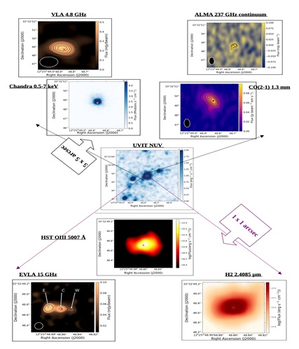Technology
Indian scientists find radio jet from dwarf galaxy interacting with interstellar gas

New Delhi, Sep 21
In a first, scientists at the Indian Institute of Astrophysics (IIA), an autonomous institute of the Department of Science and Technology (DST), have discovered interaction between a radio jet from a dwarf galaxy and interstellar gas causing shock waves.
The team found that the radio jet emitted from the Active Galactic Nuclei (AGN) -- a black hole -- from the centre of the galaxy NGC 4395. AGN is known to emit bright jets and winds and shape their galaxies.
The bright jet interacted with the surrounding interstellar medium at a small spatial scale of about or about 30 light years. The dwarf galaxy is situated at a distance of about 14 million light years.
In the study, published in a paper in the Astrophysical Journal, the team combined data from radio to X-ray wavebands from the galaxy NGC 4395 to find the interaction around the black hole.
“We decided to investigate how the radio jet from a small black hole interacts with the gas in a dwarf galaxy called NGC 4395,” said lead author Payel Nandi, and doctoral student at IIA.
The team used data from the UltraViolet Imaging Telescope (UVIT) on board AstroSat -- India’s first dedicated space observatory -- launched by ISRO in 2015, as well as Chandra for X-ray data Gemini-North and Hubble Space Telescope for optical data.
The findings showed a unique radio structure resembling a bipolar jet, whose core was centred at the black hole location.
“This jet is relatively weak, but our multi-wavelength analysis of this 30-light-year region showed that the jet is interacting with the surrounding gas, and possibly causing shock waves to propagate through it,” said Prof. C. S. Stalin at IIA, a co-author of the study.
The light emitted by the ionised oxygen in the optical band, molecular hydrogen in the infrared region, and the X-ray emission, closely match the path of the radio jet.
Nandi noted that the study found “strong evidence for an outflow of material carried by jet into the surrounding medium”.



































